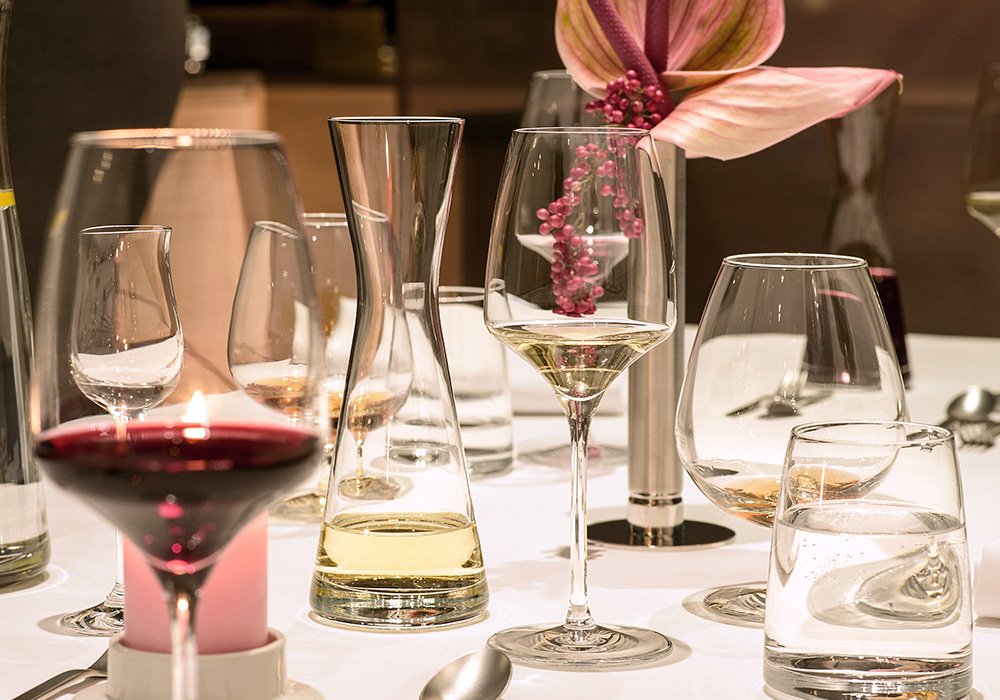In a line or in a triangle
Usually there are three glasses on the table: one for water, one for white wine and one for red wine. The so-called "Richtglas" is the glass into which the wine is poured for the main course. Usually this is the red wine glass, but if fish is served for the main course, the white wine glass takes over this position. This guide glass, which is the position where all other glasses align themselves when the table is set, is positioned in a straight line above the main course knife. There are two common ways of positioning the glasses: side by side or in a triangular shape. The first variant means that the glasses are in line at a 45° angle. Alternatively, the water glass can be placed between the red and white wine glass at the top right, creating a kind of glass triangle. If the directional glass is the only wine glass of the set on the table, the water glass, seen from the table, is at the bottom right, i.e. at four or five o'clock. If another glass is added, for example for sparkling wine or dessert wine, it is either in a straight line to the left above the red wine glass (at about ten or eleven o'clock) or above between the red and the water glass. The glass triangle then becomes a square. For more than two glasses, the glass row is therefore the more practical variant - even if it requires a little more space on the table.
The right glass
The variety of drinks accompanying the menu is of course as large as the variety of glasses. For this reason, we would like to give a short overview:
- The white wine glass is smaller than a red wine glass for a good reason: It is refilled more often so that the good drop does not stand for so long and always stays as cool as possible. That is why the glass is only touched at the stem.
- The red wine glass has a bulbous shape and a larger volume so that the red wine can breathe and develop its full bouquet. But there are subtle differences in the red wine glass: for younger red wines the goblet should be larger, for younger fruity wines (Riesling) the glasses have a curved rim. The Burgundy glass with its distinctive goblet shape, on the other hand, is ideal for spicy red wines like Pinot Noir or Blue Burgundy. Only Bordeaux glasses are even larger and more specific.
- The rules for water glasses are no longer so strict and the classic mineral water glass can be replaced by a more modern version.
- For the digestif, high proof is usually used, whereby the fruit brandy is served in a so-called Stamper without stem and the grappa in a schnapps glass with stem.
- The little brother of the wine glass is the crystal for sherry. Do not forget it: It must be kept well chilled and only half filled.
- With a short stem and a bulbous middle, the cognac swirler fits perfectly in the hand. And it should, because a good cognac unfolds only through the warmth of the palm of the hand.
- The liqueur swirl has its appearance with dessert or coffee after the menu. The small bowl with long handle was developed for liqueurs.
- The martini glass is actually only reserved for the cult cocktail. Whether shaken or stirred: a martini is served in a conical goblet with a stem.
- In order to keep the champagne sparkling for as long as possible, the already narrow glass tapers upwards.
- For the sparkling wine, on the other hand, there are three variations: the flute, bowl or fountain. They all have a stem on which the glass is held so that the sparkling wine remains cold.
- The range for beer glasses is even more extensive. Here it all depends on the contents. While the Pils is presented in an elegant tulip, there are also special glasses for Export, Alt and Kölsch or wheat beer on the well-assorted shelves of a bar.
However, an appropriate glass selection does not need a huge glass cabinet, because only glass shapes that promote a truly comprehensible taste experience make sense. Gastronomes and hoteliers should primarily pay attention to perfect quality and finest workmanship when making their selection. Only lead-free crystal glass that is seamlessly drawn from a single piece - without a transition between stem and top - can meet these high standards. Only then is the glass characterised by extraordinary breakage and rinsing resistance and is able to cope with the tough everyday life in the catering industry. With the series firstglass WMF offers a selection of collections which are exactly tailored to these requirements.










